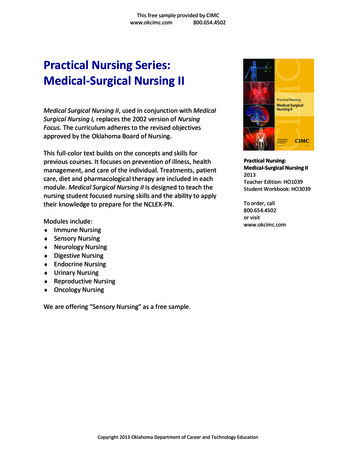Nursing Considerations - Gapssimulation.files.wordpress
Nursing ConsiderationsCJ 2019
ConsiderationsSAFETY CHECKSAnticoagulationPRESCRIPTIONFluid managementAccessObservationsInfection controlNutritionMonitoringAir EmbolusTemperature Control
Safety ChecksCheck settings & prescriptionCorrect PPE including face visorEquipment to recirculate available (1L fluid bag & spike & 3way tap OR spike with y-connector)
PrescriptionEach filter circuit should beprescribed on fresh CRRTPrescription & Monitoring formGreen DocsBlue Nurse
AccessVenousVenousBlood is withdrawn fromthe proximal lumen (arterialside) and returned throughthe distal lumen (venousside)
Pre-treatment checklist - Vascath 3 sizes of Vascath: 15cm – Right I.J./subclavian 20cm – Left I.J./subclavian 24cm - FemoralCheck that you are using the right line for the rightsite!!‘Trialsysis Lines’ available if you need an extra lumenfor access
Assess Flow AdequacyYou must be able to easily withdraw AND inject 20mls of blood in lessthe 3 secsIf unable to do so – refer to docs & NIC.Don’t start the filter before taking adviceDocument on audit form
Unused VasCath?Should be heplocked with 5000iu of heparin with volumestated on the side of the VasCathLabel, Label, Label – no-one wants to give heparin ratherthan adrenaline in an emergency!!DocumentCoag concerns? Discuss with senior medical team
SWAPPING LUMENS CAN LEAD TO RECIRCULATION& REDUCED CLEARANCE
InfectionPatients with AKI have an increased susceptibilityto infectionInfection is cited as the principle cause of death inCKD patients requiring haemodialysisCVC’s have been identified as the principle cause ofinfection.
Hooking up or off CRRT ?Surgical-ANTTMain Critical Aseptic FieldSterile Gloves
PPE
Line CareChloraPrep for skin cleansingAsceptic Non Touch TechniqueTransparent film dressings able to visualise and monitor site for inflammation /bleeding.7 days if dry & intact or as needed
MonitoringCardiac Monitoring, BP, SpO2, RR continuoustemperature monitoringFluid Balance Add up hourly Find out fluid balance aim on ward roundBloods Clotting (Anti-coag) Biochemistry – electrolytes Filter Observation Chart
TemperatureLower body temperature by as much as 4C due to heat lossvia extracorporeal circuit – 110 -200ml blood outside thebody at any time.Hypothermia: disruption of enzyme function - clotting,dysrhythmiasNeed continuous temperature monitoringReplacement fluids warmed via filter – never ever switch offthe heater!Use warming blanket if insufficient response
Fluid ManagementMost patients undergoing CRRT are oliguric, anuric or volumeoverloaded.Fluid management typically involves calculation of patients intake (infusions, feed etc) fluid loss via filter. (Also – insensible losses – e.g.loss of circuit, sweating, GI losses.)Fluid loss and Fluid balance aims should be stated explicitly onprescription form and monitored hourly on ICU chart & Obs form.
Replacement Fluid Use potassium free bags if K 5.5 Need to check & sign
ObservationsWorkshop later !
AnticoagulationAIM: To prevent clotting of extracorporeal circuit withoutharming the patientWHY? Clotting processes begin as soon as the blood hits thecircuit.HOW? Prime filter circuit with saline containing heparin if patient has normalclotting profile. Heparin infusion administered via filter. Follow the protocols on prescription chart Clotting deranged? – Check with Docs
DecisionTree
PEDVTHeparinCIRCUIT
Argatroban
Nutrition
Air EmbolusCan occur if a patient receives air in the blood returnedIn built air detectors – even microbubblesIf the systems safety mechanisms are bypassed a patientcan recieve an air embolusAir can also occur if the access cannot provide the bloodflow programmed: the blood pump will run but a vacuum is created causing air to movethrough the circuitContinually assess the circuit tubing for the presence of air
SummarySafety checks at the start of the shiftUse the prescription chart – it’s really useful!If you’re not sure – ask!!
Questions?
Fluid Management Most patients undergoing CRRT are oliguric, anuric or volume overloaded. Fluid management typically involves calculation of patients intake ( infusions, feed etc) fluid loss via filter. (Also - insensible losses - e.g. loss of circuit, sweating, GI losses.) Fluid loss and Fluid balance aims should be stated explicitly on
for Nursing (69) Delaware Board of Nursing (12) District of Columbia Board of Nursing (75) Florida Board of Nursing (70) Georgia Board of Nursing (31) Guam Board of Nurse Examiners (87) Hawaii Board of Nursing (37) Idaho Board of Nursing (82) Illinois Board of Nursing (49) Indiana State Board of Nursing (48) Iowa Board of Nursing (60)
Nursing 214 Intro to Medical Surgical Nursing 1 (9 weeks) 4 Nursing 571 Foundations of Nursing Skills Lab 0.5 MAJOR REQUIREMENTS (2nd Semester) Nursing 222 Nursing Care of Children & Families (9 weeks) 3.5 Nursing 224 Beginning Medical Surgical Nursing II 5 Nursing 226 N
GNM BSC Nursing PBBSc Nursing MSC Nursing . of Nursing Excellence, NAAC Accredited Nursing College, Part of P.D.Hinduja Hospital and Medical Research Centre which is committed to “Quality Healthcare for all” P.D.Hinduja College of Nursing is . Medical-Surgical Nursing, Obstetrics & Gynecology Nursing,
(i) Medical Surgical Nursing a Cardio Vascular & Thoracic Nursing 75-81 b Critical Care Nursing 82-88 c Medical Surgical Nursing –Oncology Nursing 89-95 d Medical Surgical Nursing - Neurosciences Nursing 96-102 e Medical Surgical Nursing
Practical Nursing Series: Medical-Surgical Nursing II This free sample provided by CIMC www.okcimc.com 800.654.4502 Medical Surgical Nursing II, used in conjunction with Medical Surgical Nursing I, replaces the 2002 version of Nursing Focus. The curriculum adheres to the revised objectives approved by the Oklahoma Board of Nursing.
Diploma in Nursing (GNM) Duration: 3 Years Bachelor of Nursing Duration: 4 Years Post Basic B.Sc. Nursing Duration: 2 Years Master of Nursing Duration: 2 Years Specialisations: 1. Medical-Surgical Nursing 2. Obstetric & Gynaecological Nursing (OBG) 3. Child Health Nursing 4. Community Health Nursing
First Year 13. Nursing Education 14. Advance Nursing Practice Clinical Speciality Medical Surgical Nursing Obstetric & Gynaecological Nursing Child Health (Paediatric) Nursing Mental Health (Psychiatric) Nursing Community Health Nursing 15. N
of general rough paths. However, in this paper, we will focus on the case where the driving signal is of bounded variation. Following [6] we interpret the whole collection of iterated integrals as a single algebraic object, known as the signature, living in the algebra of formal tensor series. This representation exposes the natural algebraic structure on the signatures of paths induced by the .























